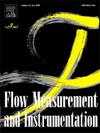Experimental investigation on two-phase flow parameters and patterns of gas-liquid flow in small-diameter helically coiled tubes
IF 2.3
3区 工程技术
Q2 ENGINEERING, MECHANICAL
引用次数: 0
Abstract
The helically coiled tube (HCT) heat exchangers, recognized for the high heat transfer coefficients and excellent thermal expansibility, are crucial devices with wide-ranging engineering applications. The unique combination of gravity and centrifugal force yields a distinctive distribution and transformation of flow patterns, emphasizing the need for precise measurement and understanding of the two-phase parameters within the HCT. This paper presented an electrical conductivity probe measurement system designed to detect two-phase flow patterns and parameters in gas-liquid flow within small-diameter HCTs, specifically with inner diameters of 6 mm and 10 mm. The influence of superficial gas and liquid velocities on flow patterns in HCTs was investigated, resulting in four distinct classifications: bubble flow, plug flow, slug flow, and annular-slug flow. Correspondingly, the voltage signals from the conductivity probes manifested as descending pulse waves, descending narrow rectangular waves, descending wide rectangular waves, and ascending pulse waves. The variations in two-phase flow parameters were analyzed, revealing that the probability density distribution of bubble chord lengths conformed to the Lorentzian peak function. Then, quantitative criteria for flow pattern classification within the HCTs were developed using primarily voltage signals and supplemented by high-speed camera imagery. The effect of the inner diameter of the HCT on the flow pattern transition boundaries was discussed. Finally, the applicability of the existing correlations for the flow transition boundaries was verified based on experimental data within small-diameter HCTs.This study provides a crucial reference basis for subsequent studies on bubble dynamics and heat transfer mechanisms within HCTs.
小直径螺旋盘管内气液两相流动参数及流型的实验研究
螺旋盘管换热器具有较高的传热系数和良好的热膨胀性能,是具有广泛工程应用的重要设备。重力和离心力的独特组合产生了独特的流动模式分布和转变,强调了精确测量和理解HCT内两相参数的必要性。本文设计了一种电导率探头测量系统,用于检测内径为6mm和10mm的小直径hct内气液两相流动模式和参数。研究了表面气体和液体速度对hct流动模式的影响,得出了四种不同的分类:气泡流动、塞流、段塞流和环空段塞流。相应的,电导率探头的电压信号表现为脉冲波下降、窄矩形波下降、宽矩形波下降、脉冲波上升。分析了两相流参数的变化规律,发现气泡弦长的概率密度分布符合洛伦兹峰函数。然后,主要使用电压信号并辅以高速相机图像,开发了hct内流型分类的定量标准。讨论了HCT内径对流型过渡边界的影响。最后,基于小直径hct内的实验数据,验证了已有关联对流动过渡边界的适用性。该研究为后续高温超导体内气泡动力学和传热机理的研究提供了重要的参考依据。
本文章由计算机程序翻译,如有差异,请以英文原文为准。
求助全文
约1分钟内获得全文
求助全文
来源期刊

Flow Measurement and Instrumentation
工程技术-工程:机械
CiteScore
4.30
自引率
13.60%
发文量
123
审稿时长
6 months
期刊介绍:
Flow Measurement and Instrumentation is dedicated to disseminating the latest research results on all aspects of flow measurement, in both closed conduits and open channels. The design of flow measurement systems involves a wide variety of multidisciplinary activities including modelling the flow sensor, the fluid flow and the sensor/fluid interactions through the use of computation techniques; the development of advanced transducer systems and their associated signal processing and the laboratory and field assessment of the overall system under ideal and disturbed conditions.
FMI is the essential forum for critical information exchange, and contributions are particularly encouraged in the following areas of interest:
Modelling: the application of mathematical and computational modelling to the interaction of fluid dynamics with flowmeters, including flowmeter behaviour, improved flowmeter design and installation problems. Application of CAD/CAE techniques to flowmeter modelling are eligible.
Design and development: the detailed design of the flowmeter head and/or signal processing aspects of novel flowmeters. Emphasis is given to papers identifying new sensor configurations, multisensor flow measurement systems, non-intrusive flow metering techniques and the application of microelectronic techniques in smart or intelligent systems.
Calibration techniques: including descriptions of new or existing calibration facilities and techniques, calibration data from different flowmeter types, and calibration intercomparison data from different laboratories.
Installation effect data: dealing with the effects of non-ideal flow conditions on flowmeters. Papers combining a theoretical understanding of flowmeter behaviour with experimental work are particularly welcome.
 求助内容:
求助内容: 应助结果提醒方式:
应助结果提醒方式:


